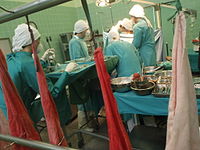
Photo from wikipedia
Refinement of immunosuppressive strategies has led to further improvement of kidney graft survival in recent years. Currently, the main limitations to long-term graft survival are life-threatening side effects of immunosuppression… Click to show full abstract
Refinement of immunosuppressive strategies has led to further improvement of kidney graft survival in recent years. Currently, the main limitations to long-term graft survival are life-threatening side effects of immunosuppression and chronic allograft injury, emphasizing the need for innovative immunosuppressive regimens that resolve this therapeutic dilemma. Several cell therapeutic approaches to immunosuppression and donor-specific unresponsiveness have been tested in early phase I and phase II clinical trials in kidney transplantation. The aim of this overview is to summarize current cell therapeutic approaches to immunosuppression in clinical kidney transplantation with a focus on myeloid suppressor cell therapy by mitomycin C-induced cells (MICs). MICs show great promise as a therapeutic agent to achieve the rapid and durable establishment of donor-unresponsiveness in living-donor kidney transplantation. Cell-based therapeutic approaches may eventually revolutionize immunosuppression in kidney transplantation in the near future.
Journal Title: Pediatric Nephrology
Year Published: 2017
Link to full text (if available)
Share on Social Media: Sign Up to like & get
recommendations!